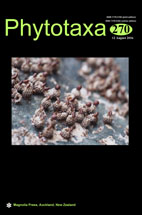Abstract
A new species, Aspidistra ronganensis, discovered in Guangxi Zhuangzu Autonomous Region of southern China, is described and illustrated. It is similar to A. retusa in the shape of the flower, but differs by the perigone tubular (vs. campanulate), 20–25 × 6–8 mm, lobes triangular-lanceolate (vs. deltoid-ovate), apex gradually acuminate (vs. subobtuse), with spurlike basal protuberances (vs. withoutr keels), anthers lineate, ca. 5 × 0. 5–1 mm (vs. ovate, 1.8 ×1.8 mm). The chromosome number of the new species was determined to be 2n = 38 + 1B, and the karyotype was formulated as 2n = 24m + 2sm + 12st + 1B. One B chromosome was observed in the chromosome complement. The average length of chromosome complement is 4.22 μm, the karyotype asymmetry indices CVCL and MCA are 63.24 and 26.20, respectively.

